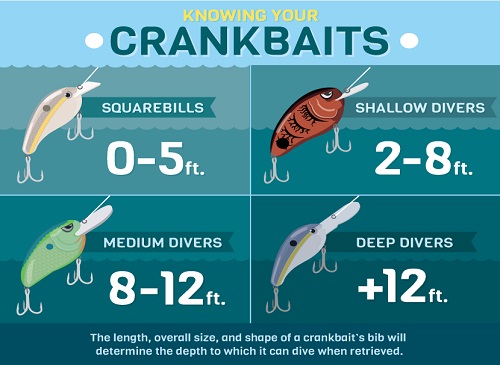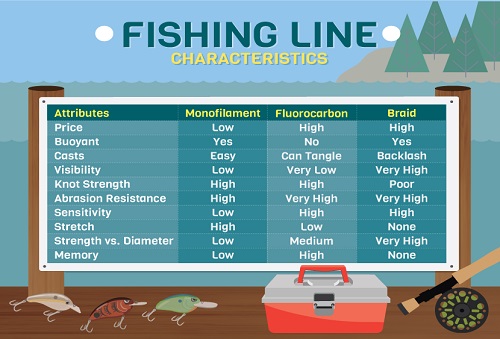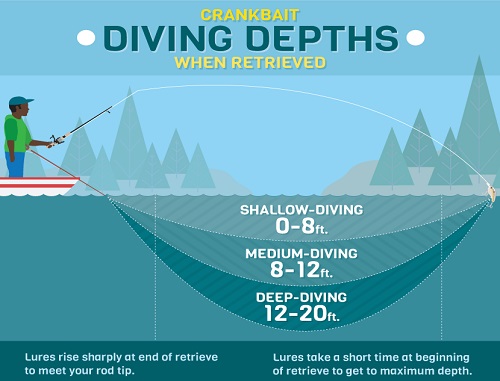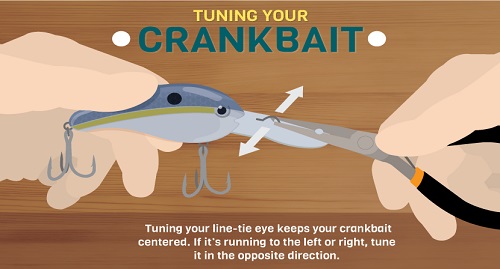 There is perhaps no lure more versatile than a crankbait. This style of lure will catch fish of all species in all seasons, whether you’re casting or trolling.
There is perhaps no lure more versatile than a crankbait. This style of lure will catch fish of all species in all seasons, whether you’re casting or trolling.
What’s a Crankbait?
Any fish that routinely eats smaller fish can be targeted with crankbaits. A lure with a plastic lip that causes a bait to dive underwater can be classified as a crankbait. The depth ranges vary from just below the surface down to 20 feet or even deeper. To simplify things, crankbaits can be grouped into four major categories:
Squarebills and Shallow Divers
The shallowest-diving crankbaits – including the popular squarebill crankbaits – work best around shallow cover. Ideal places to throw shallow crankbaits are around rocks, docks, submerged wood, and shallow grass lines. The key with shallow-diving crankbaits is to fish them with no regard to getting them hung up. While this may seem crazy for a lure that has two treble hooks attached, shallow-divers actually do not hang up often if you reel them in fast enough. When a lure deflects off a hard object, it is often the best time to catch a fish, as it causes a reaction from the fish as the lure changes direction. The body and lip of the crankbait will absorb the impact, causing the deflection, and the hooks will rarely penetrate the cover at high speeds.
Medium Divers
Medium-diving crankbaits work well in water that is shallower than 10 feet, even when they dive deeper than the water’s depth. A crankbait that dives 10 feet, for example, will be excellent in shallower water, as it will dig into the bottom and cause a disturbance. Like shallow-diving crankbaits, a deflection also triggers strikes, and a short pause after a deflection often results in a strike.
Deep Divers
A deep crankbait works well for fishing off shore structures like rock piles, creek channels, and ledges.
It takes more effort to get these crankbaits down deep and to make them stay there. Like the shallower styles, bottom contact is important, and any deflection or change in the retrieve will trigger a bite.
Spring
In most cases, the warmer the water is, the faster you want to
crank your reel handle. A steady stop-and-go retrieve will also work in all seasons. Shallow crankbaits are perfect for springtime, as many of the largest fish in the lake will begin to enter shallow water in preparation for spawning. A red crankbait used with a fast retrieve will dive into the bottom and will look like a scurrying crawfish.
Summer
As the water temperature heats up, so does the metabolism of predatory fish. This is a time of year when you can crank as fast as you want to and fish deeper than you would in other seasons. A deep-diving crankbait is the top choice when fishing off shore structures.
Fall
Fall is arguably the best season to use crankbaits. This is when the baitfish become most active and the predatory fish begin to chase them. In lakes that have shad, a white or shad-pattern crankbait with a fast retrieve is the best lure to use to cover water until you locate a concentration of fish.
Winter
Winter is time to use a flat-sided crankbait that produces a tight wobbling action. A crankbait with a wider wobble does not work as well in colder temperatures, so flat-sided crankbaits are the top choice when fished with a slow and steady retrieve.
Line Type, Size, and Diameter
Selecting fishing line is one of the most overlooked aspects of crankbait fishing. Line size and diameter greatly affect how deep your baits will dive and what action they will have. Simply put, the thinner the diameter is, the deeper a bait will dive.
In addition to the line diameter, the type of line will affect the diving depths of your crankbaits. Monofilament and braid will float, and fluorocarbon will sink. Braided line will also have the least stretch, making it the least attractive option for crankbait fishing. The lack of stretch will tend to pull hooks out of the mouth of a fish, resulting in more lost fish.
Monofilament and fluorocarbon are the top choices for crankbaits. Monofilament is ideal for shallow crankbaits, especially when you are fishing around grass, as it will not hang up as often as the sinking fluorocarbon.
Fluorocarbon is a great all-around line for crankbait fishing; it has minimal stretch, and the sinking properties will allow a crankbait to dive deeper.
Cranking Gear
Crankbaits need rods and reels specifically designed for the technique to get the most out of your lures.
A reel should be able to handle a large amount of line to get a better casting distance, and it should also have a slower gear ratio. A 5.4:1 or similar gear ratio works well for all crankbaits because of two major factors: it forces anglers to fish the baits slower, and it allows for more power during the retrieve.
Crankbait rods should be long to allow for increased casting distance and to get to the maximum diving depth. A rod that is longer than seven feet is ideal, and up to eight feet is not too long.
The rod action is another key factor, as having a rod with some give is best to allow the bait to dive deep without being held back or impeded by the rod. A good medium-heavy rod with a moderate action has a perfect balance of backbone and flexibility. Fiberglass composite rods are popular, as they provide the balance needed for casting and cranking.
Modifying Hooks
The practice of swapping treble hooks is important as hooks become dull, but changing a hook style or size can have a big impact on a crankbait’s action and dive. Each treble hook style will vary in thickness and weight, causing a lure to dive shallower or deeper. The drastic change could also negatively affect how the crankbait was designed to run, giving it little or no action. With that in mind, it is best to change out hooks for similar sizes, styles, and even the same brand to avoid affecting your bait’s action.
Tuning Your Crankbait
Making sure that your crankbait is always running straight is a priority. If not, it could be due to a defective lure, damage from an errant cast, or simply catching too many fish! The solution to fixing a straying crankbait is very easy: tune it! Needlenose pliers will allow you to slightly adjust the line tie to the opposite direction of where you want your crankbait to run. Simply put, if your crankbait is running to the left, turn the line tie to the right.
Crankbaits are among the top-producing lures for any species that eats smaller baitfish and crayfish. They allow an angler to quickly cover water and will be appealing to any fish that is in a feeding mood. They will even tempt those that are not hungry. By following these steps, you will be sure to get the most out of your crankbaits.


